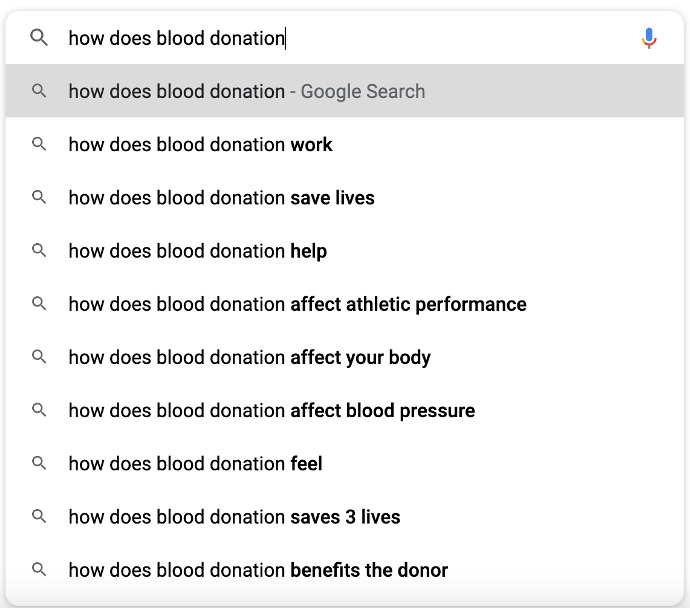
Most Commonly Googled Questions About Blood Donation — Answered by the Experts, Part 4
Have you ever turned to Google for help before a donation? Say, to find out how you could bulk up on iron, or to find out if your newfound cold would be cause for deferral? Or perhaps you asked Google a few questions before you made an appointment, to see if blood donation was right for you — whether it’s really effective, how much it hurts (which can be a daunting fear the first time), whether you’d feel tired after?
Whether you’ve directly contributed to Google’s database of questions or not, the truth is, blood donation is a very commonly searched topic. To help shed light on some of the most common inquiries and misconceptions around blood donation, we sat down with some of our SBC experts and asked them some of the most popular questions on the Internet about blood donation, as determined by the phrases Google uses to autocomplete the start to blood donation questions. For five weeks, we’re sharing answers to the top Googled questions in a few categories: “Can I donate blood…?”; “Does blood donation…?”; “How does blood donation…?”; “Are blood donations…?”; and “Do blood transfusions…?”
 This week, we’re covering the most commonly Googled questions beginning with “How does blood donation,” as answered by SBC’s Medical Director, Dr. Suchi Pandey! All the questions we’ll be answering are in this article’s header image so feel free to browse for the ones you’re especially anxious to know down below, or test your knowledge against our expert!
This week, we’re covering the most commonly Googled questions beginning with “How does blood donation,” as answered by SBC’s Medical Director, Dr. Suchi Pandey! All the questions we’ll be answering are in this article’s header image so feel free to browse for the ones you’re especially anxious to know down below, or test your knowledge against our expert!
How does blood donation work?
This can be answered a few different ways. In terms of the overall process, it can be broken down quite simply into four parts: 1. Registration, which includes signing in and answering some questions about your medical history, health and relevant risk factors for certain diseases; 2. Medical history, when you go into a private room to speak with a nurse about your answers and have your blood pressure, temperature and hemoglobin checked; 3. The donation, which takes about seven minutes for whole blood; and 4. Rest and refreshments, when you sit and eat cookies and drink juice for 10 minutes to make sure you feel good to go!
In answer to “How does blood donation work?” regarding the actual donation mechanism, a phlebotomist uses a needle to tap into a vein. The process simply uses gravity to encourage the blood to flow out for whole blood donations. For apheresis donations, whole blood is withdrawn into a machine that has a centrifuge. The centrifuge spins the whole blood, which separate the blood components by density. This allows the machine to isolate the desired product (platelets, plasma or red cells) and return the rest to the donor through the same needle.
How does blood donation save lives? / How does blood donation help?
Whole blood has a bunch of properties that make it essential for life. The red cells carry oxygen and nutrients throughout your body, and remove carbon dioxide and waste. And both platelets and plasma help to control bleeding. Different blood products are indicated to help a patient when they are low on a certain product, potentially due to underlying disease, chemotherapy or major blood loss, to name a few potential reasons (i.e., either you’re losing a blood product or not producing enough of it).
How does blood donation affect athletic performance?
For most people, the most relevant piece of information here is that you aren’t recommended to do strenuous exercise, including lift heavy objects, for 24 hours after donation while your body recovers. And, due to the loss of red cells, which helps carry oxygen throughout your body, you may feel slightly more fatigued and have a slightly reduced cardio capacity for a few days after donation.
One thing to keep in mind is that it can take the body about six or more weeks to fully restore the red cells lost during a whole blood donation, and even longer to replace the iron lost during donation. To ensure more rapid replacement of iron and hemoglobin, taking an iron supplement is recommended after blood donation. A 18–28mg dose of iron taken daily for 60 days is sufficient to replace the iron lost during a donation. For more information about iron and blood donation, please check here. For most donors, after a few days, enough red cells will have replenished for athletic performance to have returned closer to normal. However, for those who perform on a professional level, they may notice a slight change in performance until their red cells (and iron levels) have completely recovered.
How does blood donation affect your body? / How does blood donation benefit the donor?
Those who qualify to donate blood typically will donate about one pint, which, while helpful to patients in need, is not such a large loss that most people see a significant effect post-donation. Typically, the most noticeable effect is you may feel tired for a day or two after donation as your body works to replenish red cells and iron. For this reason, it’s important to take a supplement post-donation (which is preferred to simply eating increased iron) if you are able. There are also benefits to having your blood drawn, such as potentially lowering high blood pressure and burning calories, as outlined in our earlier article, part 1, “Does Blood Donation?”.
How does blood donation affect blood pressure?
In general, donating once as a person with healthy blood pressure doesn’t seem to have much of an impact. However, regular donations in hypertensive individuals is believed to help reduce blood pressure. Donating blood decreases the volume of blood in your circulatory system (since you’ve just donated some of it!), thereby decreasing blood pressure and associated risks like forming blood clots.
How does blood donation feel?
For most people, just like a pinch when the needle goes in and when the needle goes out. It’s less painful than getting a flu shot!
How does blood donation save 3 lives?
While most blood donors give whole blood, donors never really call for whole blood to be transfused. Rather, they call for specific components of the blood — either red cells, platelets or plasma (which make up about 45%, less than 1%, and 55% of whole blood, respectively) — depending on what the patient needs. When a person donates whole blood, they give all of these components together, which can then be separated in the lab and used to create three separate products, with the possibility of being transfused to three separate patients!
At Stanford Blood Center, though, we actually have a way for you to help even more patients with one donation: through research! While not all parts of your donation can be transfused to patients — namely white cells — they can be useful for researchers looking for cures and therapies to save patients in the future. SBC tries to save as much of the typically unused part of donation as possible to prepare for researchers in our area.
